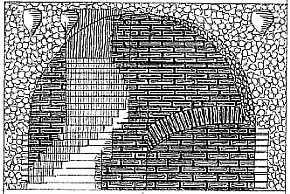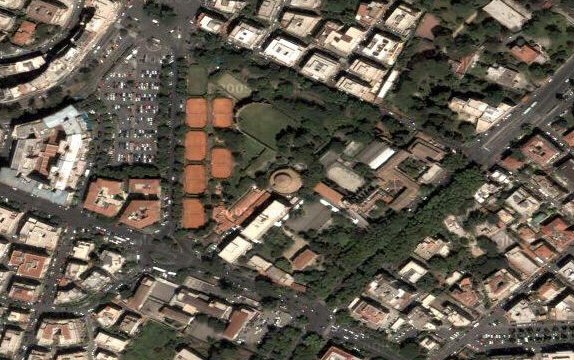29 October to 30 December: Constantine is known to have resided in Trier.

Another example of the employment of vases to lighten the construction of vaulting, from the Church of St. Sebastian, Rome.
Seroux
| |

chronology of Santa Agnese fuori le Mura
III century:
Several brickstamps on the roof of the basilica.
314-37
Foundation of a basilica with a baptistry by Constantine the Great.
337-50:
Acrostic of Constantina, in the primative basilica, preserved in the manuscripts of Prudentius, Peristephanon
349:
Sepulchral inscription in the catacomb gallery behind the high altar.
Richard Krautheimer, Corpus basilicarum Christianarum Romae: Le basiliche cristiane antichi di Roma (sec. IV-IX) (Cittá del Vaticano: Pontificio istituto di archeologia cristiana, 1937-).
| |
chronology of Santes Marcellino et Pietro
303-305:
Martyrdom of Peter and Marcellinus in Rome during the persecution under Diocletian, and burial of their remains through Lucilla, as reported to Damasus in his boyhood by the executioner himself.
313-c.320:
Brickstamps O F S R found in masonry of Mausoleum of Helena.
324-326:
Coin of Constantine, minted during these years, found embedded in mortar of Mausoleum of Helena.
314-335:
During the pontificate of Sylvester, Constantine is reported to have built "inter duas lauros" a basilica in honor of two martyrs, the presbyter Marcellinus and the exorcist Peter, and a mausoleum for his mother, Helena. "For the love of his mother and the veneration of the Saints", Constantine endowed these foundations with two sets of gifts. Firstly, a gold paten, a huge golden chandelier, four gold-plated candlesticks each 12 feet high, and a silver altar weighing 200 pounds, were placed in front of the porphyry sarcophagus of the empress. Secondly, the basilica of the martyrs was endowed with another altar weighing 200 pounds and numerous altar vessels, among them a goblet of gold, inscribed with the name of the dowager empress. The list of the endowment of the basilica continues with the enumeration of many other gifts, such as 900 pounds of nard oil and 100 pounds of balsam annually, for incense for the holy martyrs, and huge landed properties, including the fundus Laurentium which had been the property of the dowager-empress Helena, extending from Porta Maggiore to Centocelle, between Via Prenestina and the Via Latina; also other holdings in Italy and Sardinia. The whole endowment, with an income of 3750 solidi, is the largest of the donations attributed by the Liber Pontificalis to Constantine, except for those assigned to the Lateran, the Lateran baptistery and, supposedly, St. Paul's.
Richard Krautheimer, Corpus basilicarum Christianarum Romae: Le basiliche cristiane antichi di Roma (sec. IV-IX) (Cittá del Vaticano: Pontificio istituto di archeologia cristiana, 1937-).
It was also the custom then to celebrate the anniversary of martyrdom with a vigil and feast that have been compared to an Irish wake, and even the anniversary of death of ordinary Christians was commemorated with a banquet. These buildings functioned then as a sort of banquet hall as well as cemetery--at least until the bishops Ambrose and Augustine undertook an attack on these customs.
Gregory T. Armstrong, 1974.
|